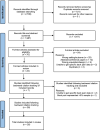Paramedic management of back pain: a scoping review
- PMID: 35945506
- PMCID: PMC9361588
- DOI: 10.1186/s12873-022-00699-1
Paramedic management of back pain: a scoping review
Abstract
Background: Research examining paramedic care of back pain is limited.
Objective: To describe ambulance service use and usual paramedic care for back pain, the effectiveness and safety of paramedic care of back pain, and the characteristics of people with back pain who seek care from paramedics.
Methods: We included published peer-reviewed studies of people with back pain who received any type of paramedic care on-scene and/or during transport to hospital. We searched MEDLINE, EMBASE, CINAHL, Web of Science and SciELO from inception to July 2022. Two authors independently screened and selected the studies, performed data extraction, and assessed the methodological quality using the PEDro, AMSTAR 2 and Hawker tools. This review followed the JBI methodological guidance for scoping reviews and PRISMA extension for scoping reviews.
Results: From 1987 articles we included 26 articles (25 unique studies) consisting of 22 observational studies, three randomised controlled trials and one review. Back pain is frequently in the top 3 reasons for calls to an ambulance service with more than two thirds of cases receiving ambulance dispatch. It takes ~ 8 min from time of call to an ambulance being dispatched and 16% of calls for back pain receive transport to hospital. Pharmacological management of back pain includes benzodiazepines, NSAIDs, opioids, nitrous oxide, and paracetamol. Non-pharmacological care is poorly reported and includes referral to alternate health service, counselling and behavioural interventions and self-care advice. Only three trials have evaluated effectiveness of paramedic treatments (TENS, active warming, and administration of opioids) and no studies provided safety or costing data.
Conclusion: Paramedics are frequently responding to people with back pain. Use of pain medicines is common but varies according to the type of back pain and setting, while non-pharmacological care is poorly reported. There is a lack of research evaluating the effectiveness and safety of paramedic care for back pain.
Keywords: Allied health personnel; Ambulances; Back pain; Emergency medical services; Health service.
© 2022. The Author(s).
Conflict of interest statement
The authors declare that they have no competing interests.
Figures
Similar articles
-
Paramedic Management of Non-Traumatic Back Pain in a Large Australian Ambulance Service: A Retrospective Study.Prehosp Disaster Med. 2025 Apr;40(2):77-85. doi: 10.1017/S1049023X25000251. Epub 2025 Apr 7. Prehosp Disaster Med. 2025. PMID: 40190091 Free PMC article.
-
Paramedic assessment of suspected or confirmed COVID-19 patients in the out-of-hospital environment: a scoping review protocol.JBI Evid Synth. 2025 Apr 1;23(4):801-811. doi: 10.11124/JBIES-24-00069. Epub 2025 Jan 7. JBI Evid Synth. 2025. PMID: 39763382
-
Out-of-hospital paramedic interactions with people living with dementia: a scoping review.Age Ageing. 2024 Jul 2;53(7):afae143. doi: 10.1093/ageing/afae143. Age Ageing. 2024. PMID: 38994589
-
Paramedic care for back pain: A review of Australian and New Zealand clinical practice guidelines.Australas Emerg Care. 2022 Dec;25(4):354-360. doi: 10.1016/j.auec.2022.05.002. Epub 2022 Jun 4. Australas Emerg Care. 2022. PMID: 35672251 Review.
-
Paramedic Practitioners within ambulance services: views of Australian policymakers, health professionals, and consumers.BMC Health Serv Res. 2025 Apr 10;25(1):533. doi: 10.1186/s12913-025-12614-y. BMC Health Serv Res. 2025. PMID: 40211306 Free PMC article.
Cited by
-
Hospitalisations for non-specific low back pain in people presenting to South Australian public hospital emergency departments.Emerg Med Australas. 2025 Feb;37(1):e14504. doi: 10.1111/1742-6723.14504. Epub 2024 Sep 18. Emerg Med Australas. 2025. PMID: 39294918 Free PMC article.
References
-
- Australian Institute of Health and Welfare. Emergency department care 2020–21: Australian hospital statistics. Table 4.9: The 20 most common principal diagnoses(a) (3‑character level) for emergency department presentations(b), states and territories, 2020–21. [Spreadsheet]. Canberra (ACT): Australian Institute of Health and Welfare. Available from: https://www.aihw.gov.au/reports-data/myhospitals/sectors/emergency-depar....
-
- Buchbinder R, Bourne A, Staples M, Lui C, Walker K, Ben-Meir M, et al. Management of patients presenting with low back pain to a private hospital emergency department in Melbourne, Australia. Emerg Med Australas. 2021. - PubMed
Publication types
MeSH terms
LinkOut - more resources
Full Text Sources
Medical
Miscellaneous



